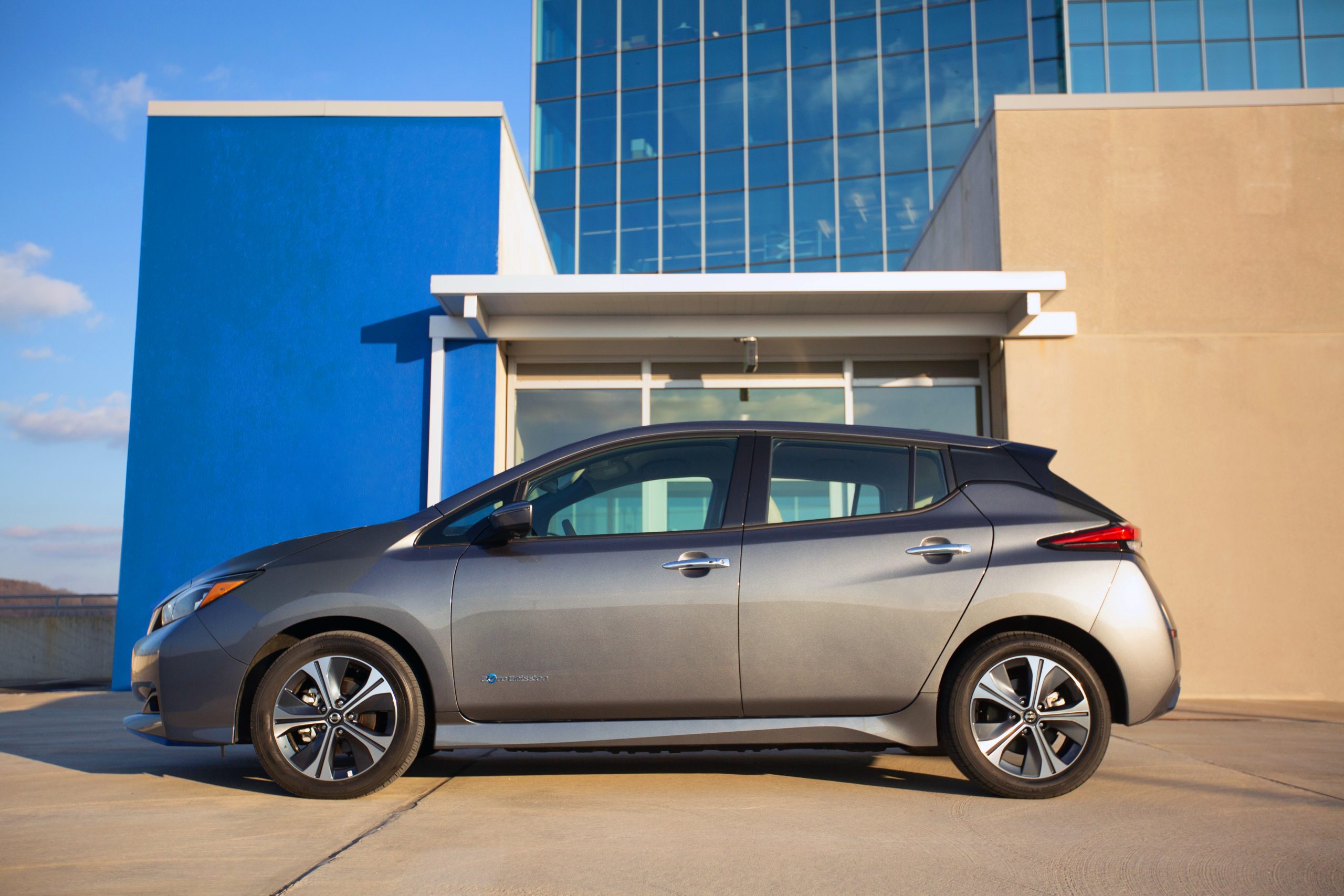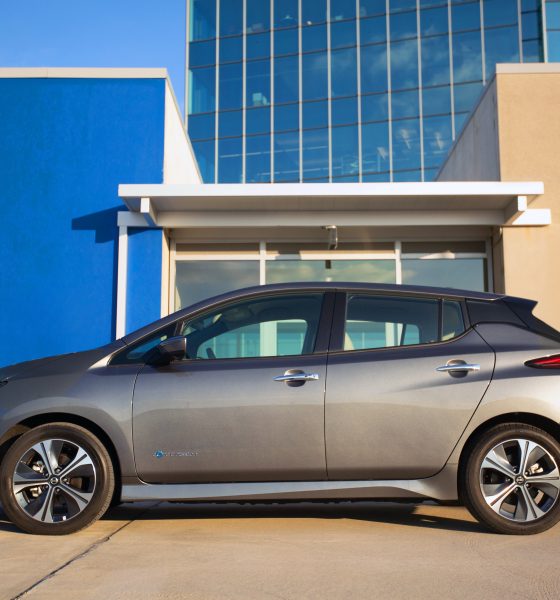Data from real-world testing involving 99 cars — half Tesla Model 3s and half Nissan Leafs — found that the Leaf was more efficient on average than the Model 3.
According to research done by Recurrent, an EV testing and analysis firm, 500,000 data points of efficiency metrics logged between November of last year and March of this year, representing roughly equal groups of Tesla Model 3s and Nissan Leafs, highlighted a strange occurrence. The Leaf group was more efficient on average than the Model 3 group — 3.7 miles per kWh compared to 3.4 miles per kWh.
Before looking at Recurrent’s results, it is important to recognize that the Model 3 is, according to multiple metrics and measuring groups, considered as one of the most efficient vehicles. According to FuelEconomy.gov, their “MPGe” (miles per gallon equivalent) metric lists the Model 3 Standard Range Plus RWD as the most efficient vehicle in their database, scoring 142 mpge. In comparison, the 2021 Hyundai Ioniq Electric scored 133 mpge, the Lucid Air 131 mpge, and the newest model Leaf 111 mpge.
Another similar study done by the American Council for an Energy-Efficient Economy (ACEEE) found that the Model 3 used some of the least energy per 100 miles compared to a variety of rivals.
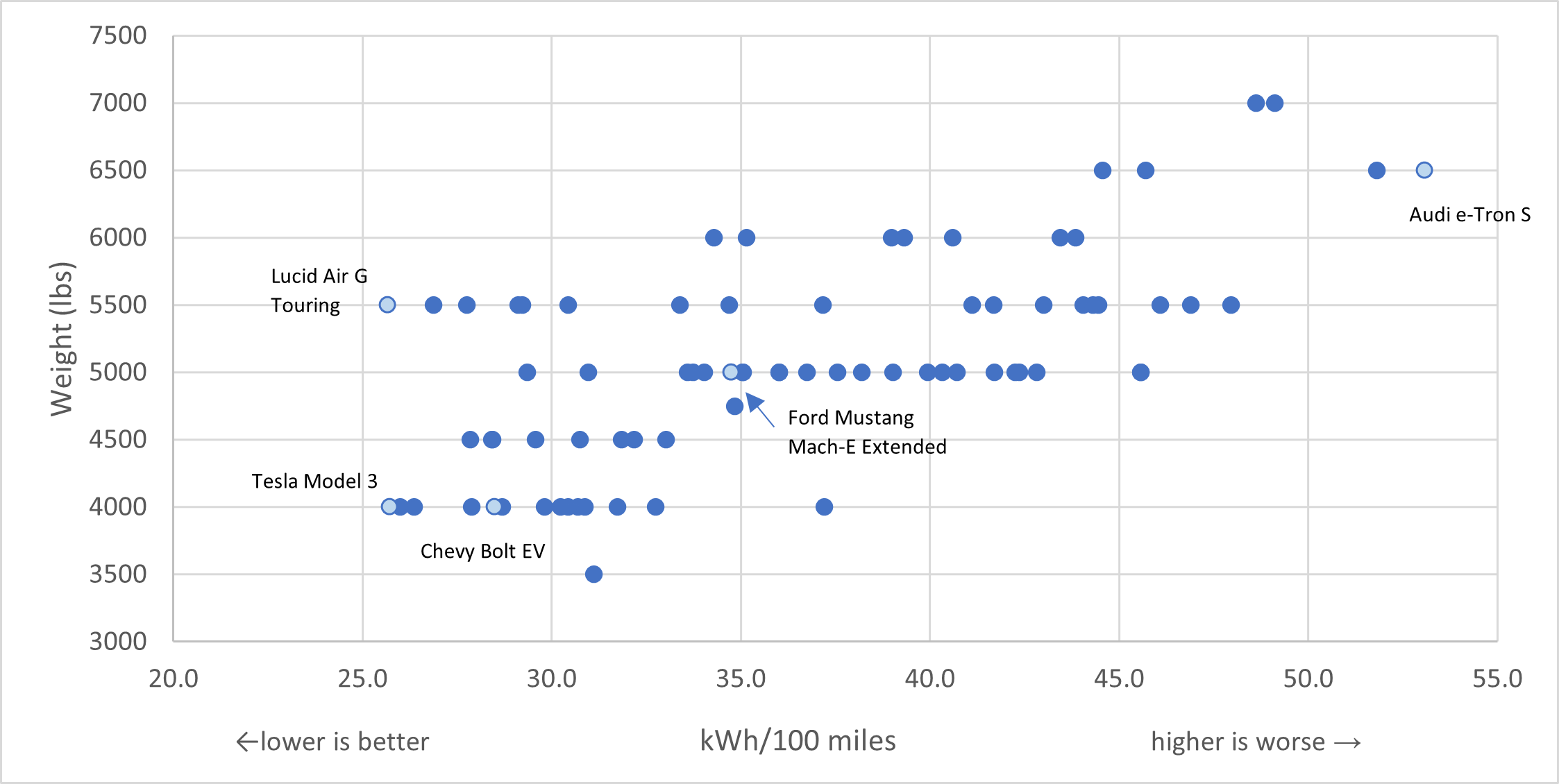
Despite these data points, Recurrent notes that the Nissan leaf proved to be the more efficient vehicle, even in adverse weather conditions. Further, older model year Nissan leafs achieved higher efficiency in most weather conditions compared to their newer counterparts.
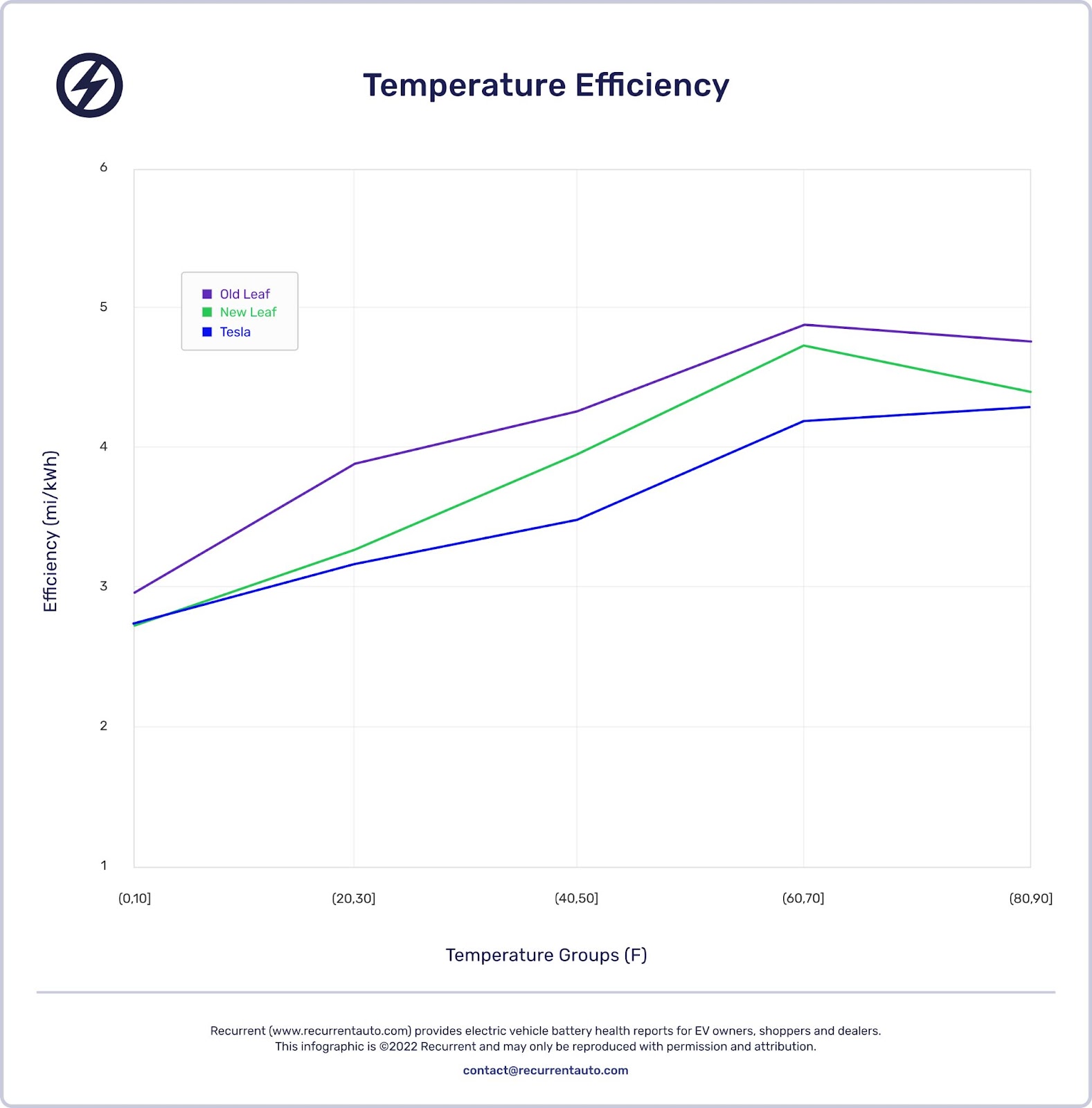
So what could have accounted for the Leaf group achieving such high levels of efficiency? Recurrent points to driver behavior as the driving factor. Nissan drivers must maximize the range that their vehicle is capable of, which is often a fairly limited total range. Recurrent says drivers are incentivized to drive more cautiously.
On the other hand, Tesla drivers may drive more “regularly”; using air conditioning, accelerating quickly, etc. Each of these factors drives down the efficiency of the Tesla vehicles.
On top of this, Recurrent says “Nissan drivers see their cars as an extension of their values. This means they are more likely to pay attention to their efficiency and alter their preferences to maximize it.”
The main takeaway should not be that Tesla has not designed an efficient vehicle, nor should it be said that Nissan (while performing admirably) has designed an incredibly efficient vehicle. The clear trend is that driver action, much like in ICE vehicles, is one of the predominant factors determining the efficiency of a vehicle.
A few questions remain nonetheless; should manufacturers be incentivizing more efficient driving, or should the primary goal be to offer the best overall experience to drivers? And as EVs become more common, will focus switch from range or charging speed to efficiency?
What do you think of the article? Do you have any comments, questions, or concerns? Shoot me an email at william@teslarati.com. You can also reach me on twitter @WilliamWritin. If you have news tips, email us at tips@teslarati.com!

News
Tesla FSD’s newest model is coming, and it sounds like ‘the last big piece of the puzzle’
“There’s a model that’s an order of magnitude larger that will be deployed in January or February 2026.”

Tesla Full Self-Driving’s newest model is coming very soon, and from what it sounds like, it could be “the last big piece of the puzzle,” as CEO Elon Musk said in late November.
During the xAI Hackathon on Tuesday, Musk was available for a Q&A session, where he revealed some details about Robotaxi and Tesla’s plans for removing Robotaxi Safety Monitors, and some information on a future FSD model.
While he said Full Self-Driving’s unsupervised capability is “pretty much solved,” and confirmed it will remove Safety Monitors in the next three weeks, questions about the company’s ability to give this FSD version to current owners came to mind.
Musk said a new FSD model is coming in about a month or two that will be an order-of-magnitude larger and will include more reasoning and reinforcement learning.
He said:
“There’s a model that’s an order of magnitude larger that will be deployed in January or February 2026. We’re gonna add a lot of reasoning and RL (reinforcement learning). To get to serious scale, Tesla will probably need to build a giant chip fab. To have a few hundred gigawatts of AI chips per year, I don’t see that capability coming online fast enough, so we will probably have to build a fab.”
NEWS: Elon Musk says FSD Unsupervised is “pretty much solved at this point” and that @Tesla will be launching Robotaxis with no safety monitors in about 3 weeks in Austin, Texas. He also teased a new FSD model is coming in about 1-2 months.
“We’re just going through validation… https://t.co/Msne72cgMB pic.twitter.com/i3wfKX3Z0r
— Sawyer Merritt (@SawyerMerritt) December 10, 2025
It rings back to late November when Musk said that v14.3 “is where the last big piece of the puzzle finally lands.”
With the advancements made through Full Self-Driving v14 and v14.2, there seems to be a greater confidence in solving self-driving completely. Musk has also personally said that driver monitoring has been more relaxed, and looking at your phone won’t prompt as many alerts in the latest v14.2.1.
This is another indication that Tesla is getting closer to allowing people to take their eyes off the road completely.
Along with the Robotaxi program’s success, there is evidence that Tesla could be close to solving FSD. However, it is not perfect. We’ve had our own complaints with FSD, and although we feel it is the best ADAS on the market, it is not, in its current form, able to perform everything needed on roads.
But it is close.
That’s why there is some legitimate belief that Tesla could be releasing a version capable of no supervision in the coming months.
All we can say is, we’ll see.
Investor's Corner
SpaceX IPO is coming, CEO Elon Musk confirms
However, it appears Musk is ready for SpaceX to go public, as Ars Technica Senior Space Editor Eric Berger wrote an op-ed that indicated he thought SpaceX would go public soon. Musk replied, basically confirming it.

Elon Musk confirmed through a post on X that a SpaceX initial public offering (IPO) is on the way after hinting at it several times earlier this year.
It also comes one day after Bloomberg reported that SpaceX was aiming for a valuation of $1.5 trillion, adding that it wanted to raise $30 billion.
Musk has been transparent for most of the year that he wanted to try to figure out a way to get Tesla shareholders to invest in SpaceX, giving them access to the stock.
He has also recognized the issues of having a public stock, like litigation exposure, quarterly reporting pressures, and other inconveniences.
However, it appears Musk is ready for SpaceX to go public, as Ars Technica Senior Space Editor Eric Berger wrote an op-ed that indicated he thought SpaceX would go public soon.
Musk replied, basically confirming it:
As usual, Eric is accurate
— Elon Musk (@elonmusk) December 10, 2025
Berger believes the IPO would help support the need for $30 billion or more in capital needed to fund AI integration projects, such as space-based data centers and lunar satellite factories. Musk confirmed recently that SpaceX “will be doing” data centers in orbit.
AI appears to be a “key part” of SpaceX getting to Musk, Berger also wrote. When writing about whether or not Optimus is a viable project and product for the company, he says that none of that matters. Musk thinks it is, and that’s all that matters.
It seems like Musk has certainly mulled something this big for a very long time, and the idea of taking SpaceX public is not just likely; it is necessary for the company to get to Mars.
The details of when SpaceX will finally hit that public status are not known. Many of the reports that came out over the past few days indicate it would happen in 2026, so sooner rather than later.
But there are a lot of things on Musk’s plate early next year, especially with Cybercab production, the potential launch of Unsupervised Full Self-Driving, and the Roadster unveiling, all planned for Q1.
News
Tesla adds 15th automaker to Supercharger access in 2025
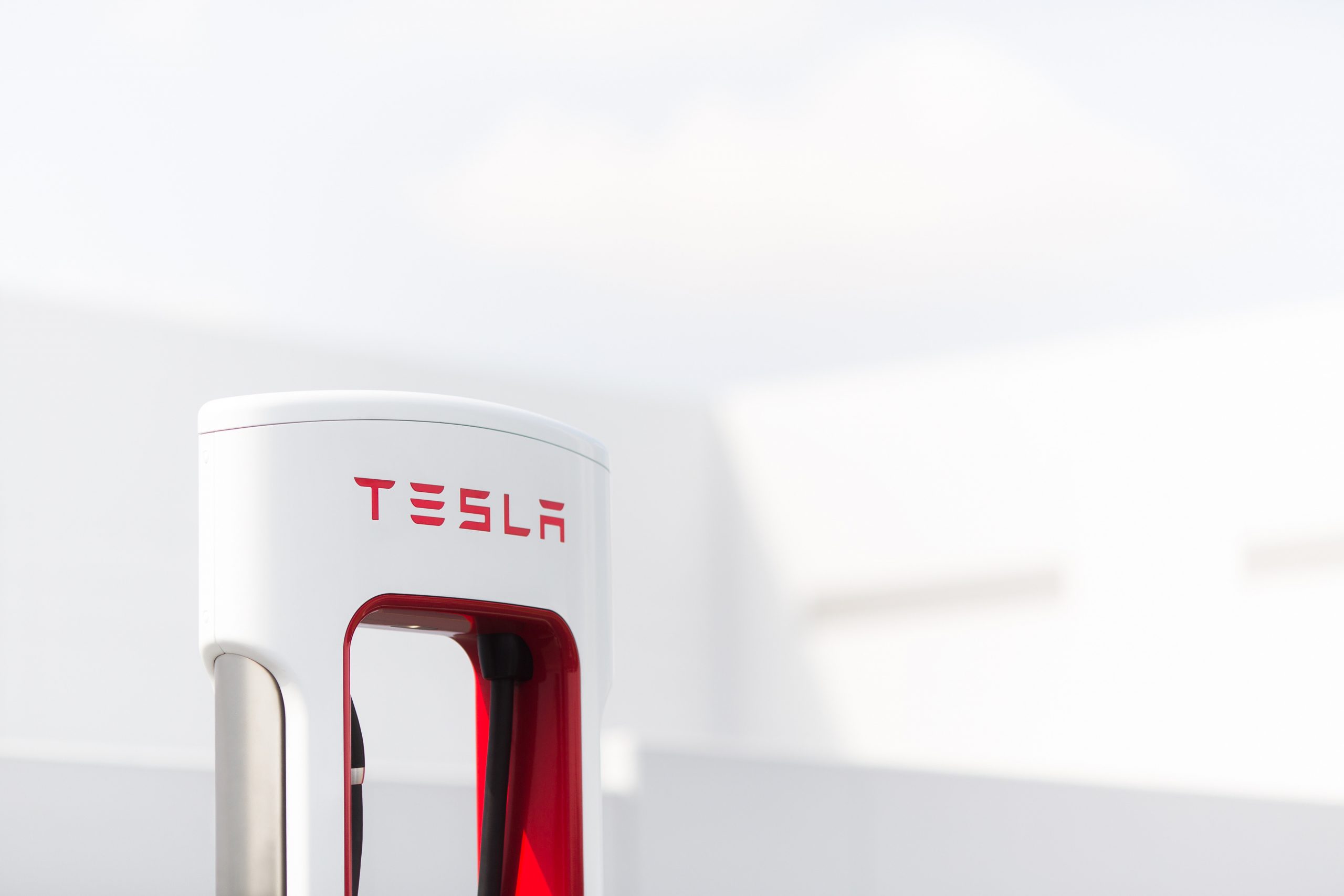
Tesla has added the 15th automaker to the growing list of companies whose EVs can utilize the Supercharger Network this year, as BMW is the latest company to gain access to the largest charging infrastructure in the world.
BMW became the 15th company in 2025 to gain Tesla Supercharger access, after the company confirmed to its EV owners that they could use any of the more than 25,000 Supercharging stalls in North America.
Welcome @BMW owners.
Download the Tesla app to charge → https://t.co/vnu0NHA7Ab
— Tesla Charging (@TeslaCharging) December 10, 2025
Newer BMW all-electric cars, like the i4, i5, i7, and iX, are able to utilize Tesla’s V3 and V4 Superchargers. These are the exact model years, via the BMW Blog:
- i4: 2022-2026 model years
- i5: 2024-2025 model years
- 2026 i5 (eDrive40 and xDrive40) after software update in Spring 2026
- i7: 2023-2026 model years
- iX: 2022-2025 model years
- 2026 iX (all versions) after software update in Spring 2026
With the expansion of the companies that gained access in 2025 to the Tesla Supercharger Network, a vast majority of non-Tesla EVs are able to use the charging stalls to gain range in their cars.
So far in 2025, Tesla has enabled Supercharger access to:
- Audi
- BMW
- Genesis
- Honda
- Hyundai
- Jaguar Land Rover
- Kia
- Lucid
- Mercedes-Benz
- Nissan
- Polestar
- Subaru
- Toyota
- Volkswagen
- Volvo
Drivers with BMW EVs who wish to charge at Tesla Superchargers must use an NACS-to-CCS1 adapter. In Q2 2026, BMW plans to release its official adapter, but there are third-party options available in the meantime.
They will also have to use the Tesla App to enable Supercharging access to determine rates and availability. It is a relatively seamless process.
